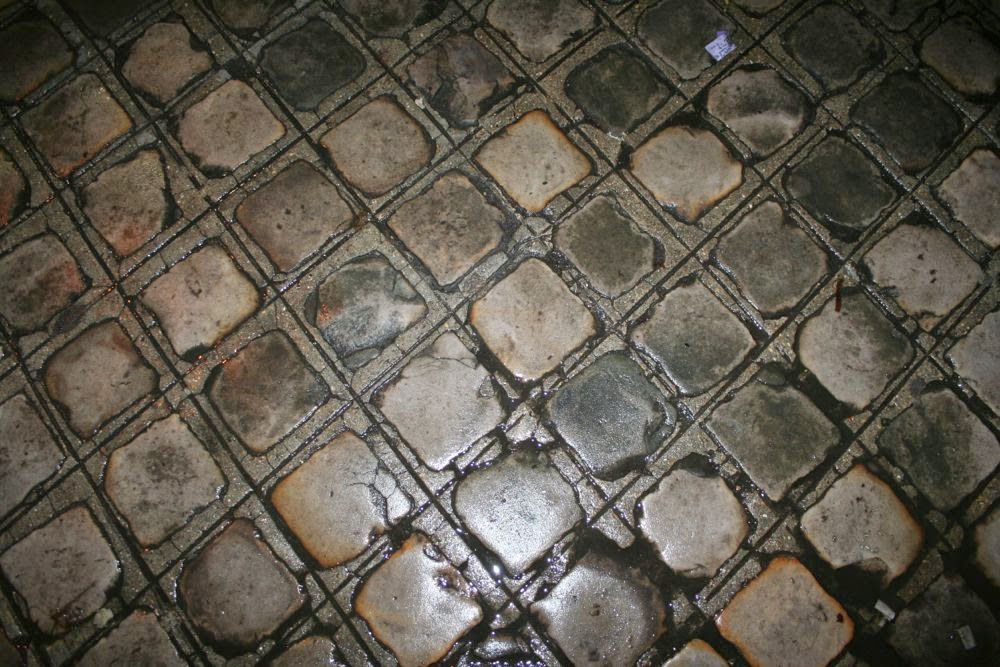the paris quilt
The second quilt I ever made has always been called the Paris quilt. In 2008, I spent five days trudging around the cold, rainy streets of Paris. As beautiful as Paris was, in damp February it was a bit lost on my homesick soul. In the days before I knew anything about sensible footwear, I spent all of those five days in soaking wet ballet flats. I really felt the painting by Caillebotte I had studied in art history. It was my second trip to France and the year prior our trip to Paris was just a few weeks before we returned to the States. This trip was scheduled for earlier in our stay and that correlation between going home and Paris was difficult to separate. Even though I was in city steeped in beauty and inspiration I was so very homesick. The grey days took their toll.
Then one night I snapped this photograph.
It was the old worn stones that brought me a strange sense of comfort. They were my muse to venture into the art of whole cloth quilting. These are the pages from my notebook:
Sitting in our downstairs Fibers studio I began composing my thoughts through studies in watercolor.
Tea had played such an important role in our daily lives. The schedule for meals had lunch at noon and dinner at seven. In order to last those hours between the Mademoiselles de Fil would have tea promptly at three each afternoon. Having no experience in dyeing I chose to begin my adventure in tea-staining.
I grabbed a load of tea varieties at the Supermarche and began making samples.
There were three fabrics to use for the back, front, and binding. Each one was dyed to experiment with the color.
The process began with the tea but the color was not as bold as I envisioned. With a brief instruction from my classmates and Madame Pamela, I managed to find dye-stuffs in the Apt art supply store that would add the desired depth.
Layer one of dyeing was tea. The second layer I added dye to the tea.
Following the dye, the dark lines were painted on with a French quill and India ink. [The quill I still have and is my favorite brush.]
Doris' "clown-hands" lecture would come the following term.
This small terrace overlooking the valley was my workspace.
I believe it was M. Pam that snapped the photos of me working and she had the foresight to take a quick shot of the view as well. Merci beaucoup!
The top drying in the sun.
Once the top had dried and been through a few wash cycles, the layers were stacked and pinned together. Batting was, for some reason, difficult to purchase in France. A supply was hard to come by, so my mother sent a few yards from the quilt shop in Wakarusa. [Thank you, Mom!]
Hand-stitching was a must and took quite a long time. This is when, at the urging of classmates and Madame Pamela, I purchased my first leather thimble. It has been a staple in my stitching ever since.
The final piece hanging at our end of term Vernissage. It was hung a few feet away from the wall so the back could be viewed.
Lexi helped me to snap a few close-up shots when I returned to Savannah.
This piece was very significant. Its creation helped to right me from homesickness as well as really stretch my artistic process. Until that point I had never put such extensive planning and foresight into my work. There was so many layers beyond the three that made the piece.
I now sleep under this blanket every night. It is so warm and time has softened it. I am still very proud of it.





















You should always be proud of this quilt! I enjoyed going back in time to France with you on this post Sharon :0) xoxo
ReplyDeleteThis was a great read, such an interesting peek into your artistic process. I also love the 2008 photos of you working... that hair! :)
ReplyDelete